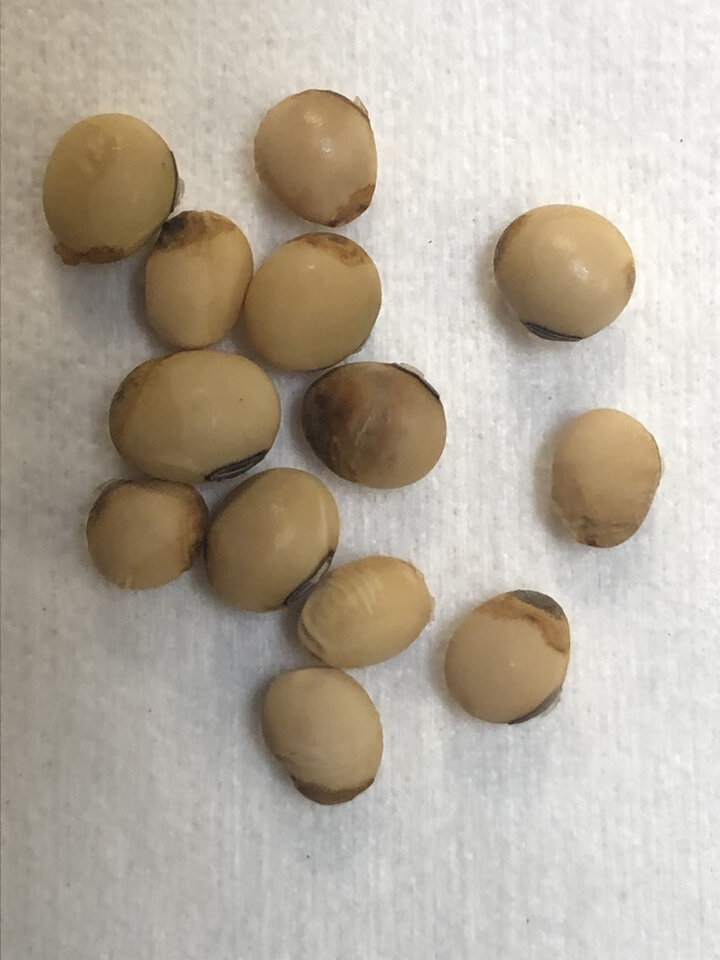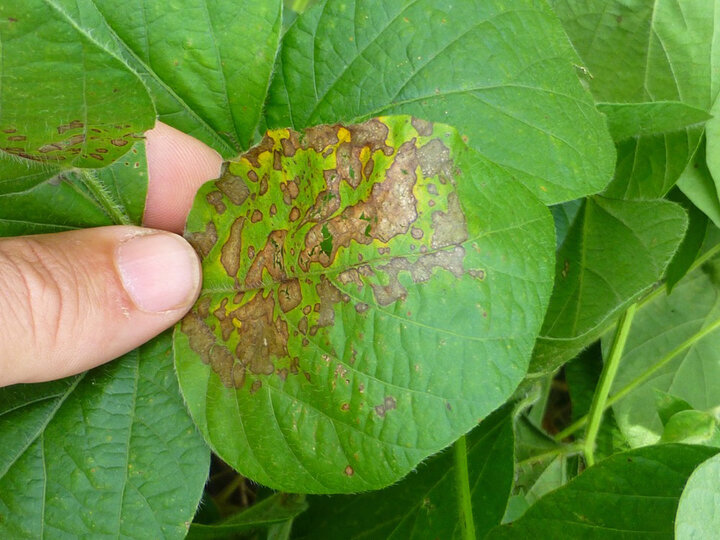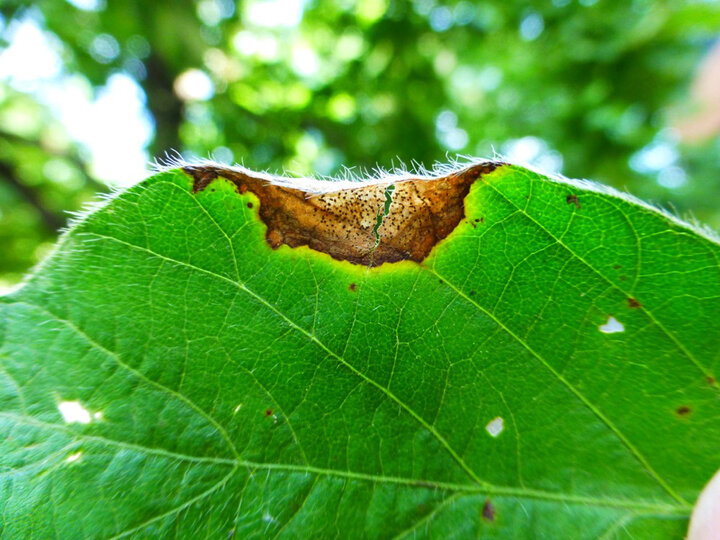Frogeye leaf spot (FLS) of soybean is an important disease in Nebraska. While FLS has not yet been confirmed in the state during the 2022 growing season, producers should expect to see disease symptoms in the next few weeks. The disease can cause significant yield loss but there are effective management options available. Below is a summary of recent research results and management recommendations that can help you control FLS in your fields.
In 2019, research funded by the Nebraska Soybean Board identified QoI (Strobilurin, FRAC group 11) fungicide resistance was detected in soybean frogeye leaf spot samples from 10 Nebraska counties. In the following year (2020), sample collection was further expanded and QoI fungicide resistance was detected in 128 fields across 48 Nebraska counties (Figure 1). Of the 2020 samples collected, 100% were found to have some level of QoI fungicide resistance.
This survey finding indicates that fungicide resistance in the frogeye leaf spot pathogen is widespread within the state. This finding means that previously effective QoI fungicides will no longer control the pathogen as they once did, nor will higher rates of the products. Due to this loss, producers will need to select fungicides with different or mixed modes of action (MOA), like FRAC groups 3 (DMI Triazoles) or 7 (SDHI Carboxamides).

Symptoms
FLS is a foliar disease of soybean caused by a fungal pathogen, Cercospora sojina (Figure 2). However, seeds, pods and stems can also be infected (Figure 3) [7]. The spots are circular in shape with a size ranging from 1/32 to 1/4 inch. Initially, they appear as dark water-soaked spots, but later appear brown in color with reddish-purple margins. Younger leaves in the upper canopy are more susceptible than older fully expanded leaves [6]. Infection can occur at any time during soybean growth and development but is more common after flowering [8].
Symptoms may look like those of Phyllosticta leaf spot, caused by the fungus Pleosphaerulina sojicola (or Phyllosticta sojicola). Lesions of Phyllosticta leaf spot appear tan or gray with a dark margin and can vary in shape as circular or oval (Figure 4). Mature Phyllosticta lesions may have black specks (fungal reproductive structures) visible in the center (Figure 5), in contrast to lesions of frogeye leaf spot [16]. For more information, see the related article from the Crop Protection Network on Phyllosticta leaf spot.




Yield loss
The presence of frogeye leaf spot lesions reduces the function of the leaves; in severe cases, causing premature loss of leaves. Reduced function and/or premature defoliation results in reduced seed weight [1]. The estimated yield loss across the United States is up to 35%, while in Nebraska, the yield loss in some highly susceptible varieties is up to 20% [2, 3]. Results from field trials suggest an integrated disease management approach including tillage (when practical), crop rotation, resistant varieties, and timely application of mixed mode of action foliar fungicides [6] provides the best control.
Disease Cycle
FLS is a polycyclic disease (Figure 6) that continues to repeat and spread as long as conditions are favorable. The pathogen Cercospora sojina survives on infected seeds and in infested soybean residue for up to two years. Infected leaves/stems/pods produce conidiophores that produce conidia (spores) which are the sources of inoculum. Splashing rain, irrigation water and wind disperse conidia.
The severity of the disease is determined by the amount of primary inoculum (in the field, on seed) and the number of secondary disease cycles that occur. Environmental conditions that favor the disease include warm temperature (77-86°F) and wet weather (frequent rainfall or irrigation) with a relative humidity of >90%. The lesions are visible seven to 14 days after infection. If warm, humid conditions persist, the pathogen produces spores intensively, increasing the disease severity. If plants in the field are infected, the infested crop residue left after harvest acts as a source of primary inoculum and infects the next soybean crop [2, 8, 9].
An Integrated Disease Management Plan
Pre-planting or Field Related Decisions
FLS is caused by a residue- and seed-borne fungus. Continuous soybean planting and minimum tillage practices increase the risk of disease development. Crop rotation with non-host crops, such as corn, sorghum and small grains can interrupt the disease cycle of the pathogen, thereby reducing the inoculum level and disease incidence when growing future soybean crops. Crop rotation should be practiced for two or more years away from soybean, depending upon the disease history in the field [2]. Tillage practices bury the infested crop residue, promoting degradation and reducing the amount of primary inoculum and future disease severity, but may not be practical [9].


Choice of Cultivars
Selecting high-quality and certified seed reduces the risk of introducing the fungus into fields via infected seeds. Planting disease-resistant varieties is a very efficient and economical way of managing foliar diseases. Soybean varieties can vary in their level of resistance. Growers should consult with seed company representatives and review disease ratings to identify resistant varieties [9]. Resistance gene Rcs3 has been reported to be resistant against all known races of the FLS pathogen in the United States [10].
Scouting
In addition to weeds and insects, growers should scout soybean fields for leaf spots (Figure 2). Dark irregular spots on stunted soybeans may be an early warning sign of FLS. If growers are unsure about the identity of a problem, they can collect samples and send them to the UNL Plant and Pest Diagnostic Clinic or contact their local extension educator with questions. For help with knowing what to look for, watch Video 1.
Video 1: Frogeye Leaf Spot Identification and Management
Application of Foliar Fungicides
Fungicide applications can effectively control FLS. Products applied to soybeans in reproductive stages R3 to R5 are most effective. R3 is the beginning of pod development whereas R5 is the beginning of seed development [2]. If FLS continues to spread after a timely fungicide application, it may indicate fungicide resistance [11]. Group 11 Quinone Outside Inhibitor (QoI) fungicides (formerly referred to as “strobilurin”) were historically the most effective and widely used for management of FLS.
Since 2010, resistance to this class of fungicides has been documented in the FLS pathogen in numerous other states. The first confirmation of QoI fungicide resistance in Nebraska was identified in a 2019 survey of 10 counties [14]. In 2020, sample collection was expanded to 48 Nebraska counties (highlighted yellow in the map Figure 1). A total of 375 samples were collected from 128 fields across 48 counties. One-hundred percent of the collected samples were found to be resistant to QoI fungicides.
Similarly, nearly all the fungal isolates collected and tested from Iowa soybean fields in 51 counties were also resistant to QoI fungicides (12) and similar scenarios have been reported for several other states.
In 2022, soybean fields with a history of FLS should be monitored carefully for disease development.
The efficacy of fungicides for disease control is determined by the product choice, application method and timing of the application [13]. Growers should consider alternative fungicides for FLS management and avoid spraying products that only contain Group 11 QoI active ingredients. Products with two or more effective active ingredients with mixed modes of action will be more likely to provide effective control of the disease. Efficacy ratings of commercially available fungicides on FLS can be found in the Crop Protection Network’s publication on Fungicide Efficacy for Control of Soybean Foliar Diseases.
Contact
For help identifying a disease or other plant problem, consider submitting a sample to the UNL Plant and Pest Diagnostic Clinic. Updated guidelines, fees and the sample submission form are available online.
Learn More
For more information, download the Frogeye Leaf Spot publication from the Crop Protection Network or visit CropWatch’s frogeye leaf spot page.
Additional Resources
- Andreas Westphal, T. Scott Abney, and Gregory Shaner. Diseases of soybean-Frogeye leaf spot. Purdue University Department of Botany and Plant Pathology and USDA-ARS. Purdue extension BP-131-W.
- Wise K, Bradley C, Sikora E, Mueller D, Chilvers M, Giesler L, et al. Crop Protection Network. Frogeye Leaf Spot. 2016. doi:10.31274/cpn-20190620-013.
- Loren Giesler. Frogeye Leaf Spot. CropWatch. 18 Sep 2015.
- Haskell RJ, Royal J. Haskell, United States. Diseases of cereal and forage crops in the United States in 1923 /. 1924. doi:10.5962/bhl.title.85565.
- Loren Giesler. Frogeye leaf spot in soybeans in eastern Nebraska. CropWatch. July 27, 2017.
- Loren Giesler, Joshua Miller. Managing foliar diseases of soybean. Extension publication. G.1862 index: Crops, Crop protection/field crops. May 2017.
- Dashiell KE, Akem CN. Yield losses in soybeans from frogeye leaf spot caused by Cercospora sojina. Crop Protection. 1991. pp. 465–468. doi:10.1016/s0261-2194(91)80134-2
- Black R. Compendium of Soybean Diseases, 4th edn, ed. G. L. Hartman, J. B. Sinclair & J. C. Rupe. vi 100 pp. St. Paul, Minnesota: APS Press (1999). ISBN 0 89054 238 4. The Journal of Agricultural Science. 2000. pp. 95–100. doi:10.1017/s0021859699247843
- Lin, B. and Kelly, H. 2018. Frogeye Leaf Spot of Soybean. The Plant Health Instructor. DOI: 10.1094/PHI-I-2018-1018-01.
- Mian MAR, Missaoui AM, Walker DR, Phillips DV, Boerma HR. Frogeye Leaf Spot of Soybean: A Review and Proposed Race Designations for Isolates of Cercospora sojina Hara. Crop Science. 2008. pp. 14–24. doi:10.2135/cropsci2007.08.0432.
- Loren Giesler. Frogeye leaf spot in soybeans in eastern Nebraska. CropWatch. 2013. http://extensionpublications.unl.edu/assets/pdf/g2213.pdf
- Ethan Stoetzer, Daren Mueller. Instances of Frogeye Leaf Spot Resistance to QoIs Abundant in Iowa. ISU Extension and Outreach. January 27, 2020.
- Jackson-Ziems, Tamra A.; Giesler, Loren J.; Harveson, Robert M.; Wegulo, Stephen N.; Korus, Kevin; and Adesemoye, Anthony O. Fungicide Application Timing and Disease Control (2016). Papers in Plant Pathology. 486.
- Neves, D. L., Chilvers, M. I., Jackson-Ziems, T. A., Malvick, D. K., & Bradley, C. A. (2020). Resistance to quinone outside inhibitor fungicides conferred by the G143A mutation in Cercospora sojina (causal agent of frogeye leaf spot) isolates from Michigan, Minnesota, and Nebraska soybean fields. Plant Health Progress Brief.
- Mengistu, A., Kelly, M. H., Bellaloui, N., Arelli, R. P., Reddy, N. K., and Wrather, J. A. 2014. Tillage, fungicide and cultivar effects on frogeye leaf spot severity and yield in soybean. Plant Dis. 98:1476-1484.
- Daren Mueller or Adam Sisson. Phyllosticta leaf spot of soybean. Crop Protection Network.
